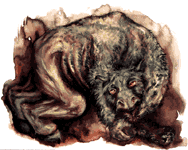
Minotaur: Circle 7, Inferno 12 The path down to the three rings of circle 7 is covered with a mass of boulders that fell--as Virgil explains (Inf. 12.31-45)--during the earthquake triggered by Christ's harrowing of hell. The Minotaur, a bull-man who appears on this broken slope (Inf. 12.11-15), is most likely a guardian and symbol of the entire circle of violence. Dante does not specify whether the Minotaur has a man's head and bull's body or the other way around (sources support both possibilities), but he clearly underscores the bestial rage of the hybrid creature. At the site of Dante and Virgil, the Minotaur bites himself, and his frenzied bucking--set off by Virgil's mention of the monster's executioner--allows the travelers to proceed unharmed. Almost everything about the Minotaur's story--from his creation to his demise--contains some form of violence. Pasiphaë, wife of King Minos of Crete, lusted after a beautiful white stag and asked Daedalus to construct a "fake cow" (Inf. 12.13) in which she could enter to induce the bull to mate with her; Daedalus obliged and the Minotaur was conceived. Minos wisely had Daedalus build an elaborate labyrinth to conceal and contain this monstrosity. To punish the Athenians, who had killed his son, Minos supplied the Minotaur with an annual sacrificial offering of seven Athenian boys and seven Athenian girls. When Ariadne (the Minotaur's half-sister: Inf. 12.20) fell in love with one of these boys (Theseus, Duke of Athens: Inf. 12.16-18), the two of them devised a plan to slay the Minotaur: Theseus entered the labyrinth with a sword and a ball of thread, which he unwound as he proceeded toward the center; having slain the Minotaur, Theseus was thus able to retrace his steps and escape the labyrinth. |